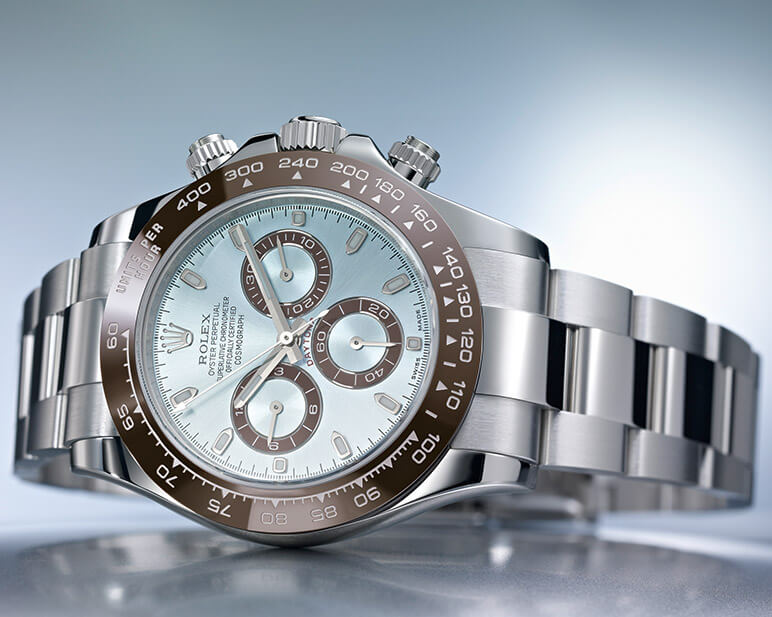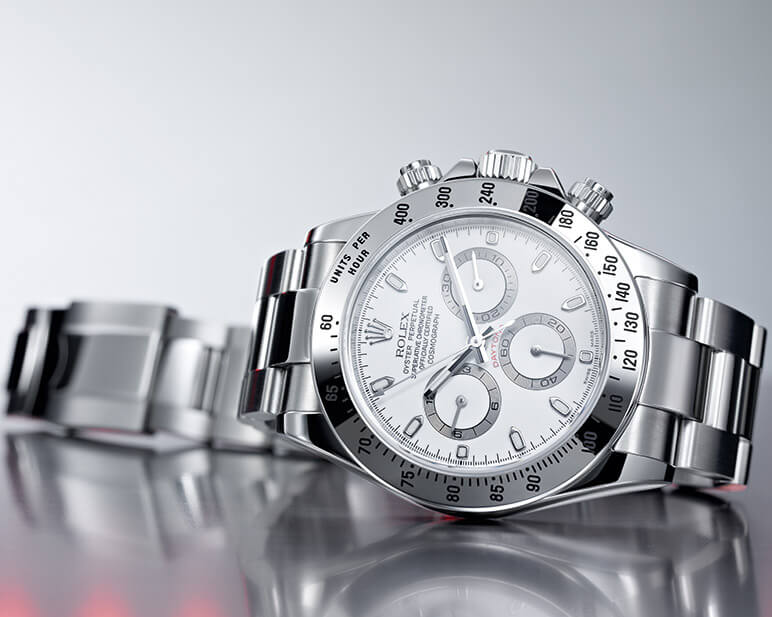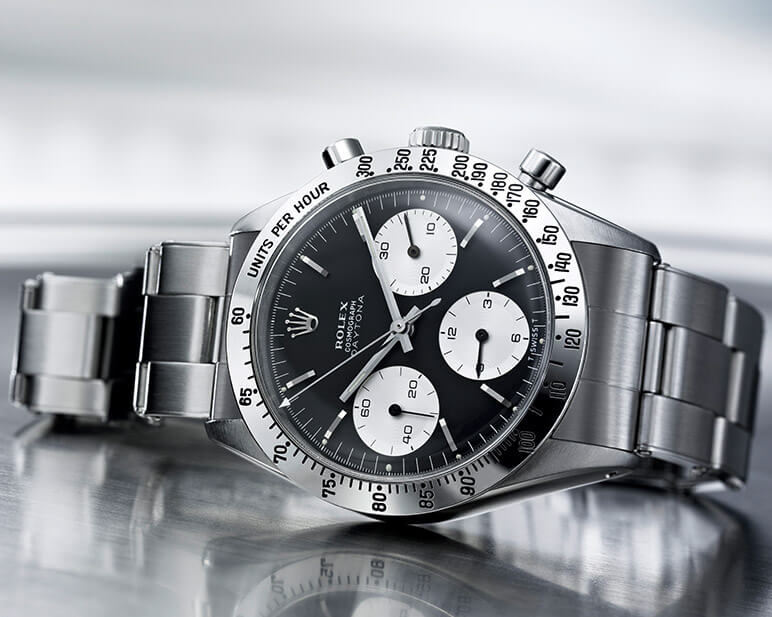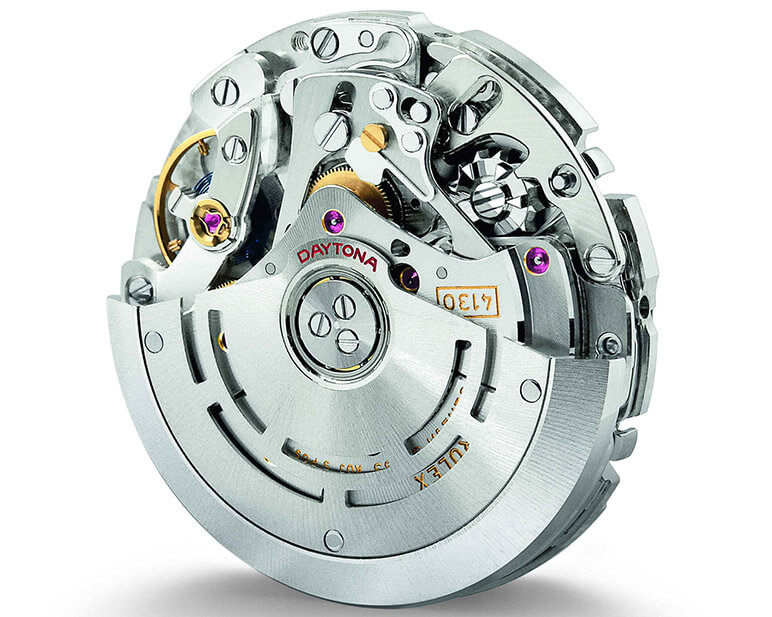At 50 years old, one of the most famous watches ever hasn’t aged a day. Half a century after its launch, it is as desirable as ever. Nor has the Rolex Oyster Perpetual Cosmograph Daytona, to give it its full name, undergone any kind of radical facelift for its jubilee year. Rather, Rolex is contenting itself with a version in platinum with an ice blue dial.
The reason Rolex is keeping this anniversary low key is that throughout its five decades, the Daytona has never ceased to evolve. As its name suggests, the history of this watch is tied to the thrill of speed. Created by Rolex in 1963, it earned its stripes on the racing circuit. Never has a product been so closely linked to one particular sport, with the one possible exception of Blancpain’s Fifty Fathoms, widely considered to be the first military dive watch.
A watch that embodies Rolex values
The Oyster Perpetual Cosmograph Daytona is the perfect illustration of what Rolex stands for, a company that employs more than 9,000 people, spread between the head office in Geneva, the production site in Biel, and the company’s worldwide subsidiaries. Discreet yet omnipresent, Rolex gives little away. Understanding the philosophy behind this independent brand therefore means reading between the lines, including with this exceptional watch. Objectively, we can praise its performance, precision, legibility, robustness and reliability. Design-wise, it corresponds exactly to the attitude of a group that produces close to 800,000 watches a year, and which favours timeless elegance as a symbol of prestige for the wearer. Such is the alchemy of Rolex, to embody the brand in a single watch.
The Daytona wasn’t always called the Daytona. Before lending its name to one of Rolex’s most iconic models, the Florida city had forged its reputation, as of 1903, by hosting land speed records on its long stretch of beach. The construction of a speedway only added to its fame. In 1963, Rolex launched the Cosmograph, a new-generation chrono for racing drivers. This new watch stood out for the chronograph subdials in a contrasting colour to the main dial, with black counters on a light-coloured dial or light-coloured counters on a black dial. The tachymeter scale, used to calculate average speed over a given distance, was moved from the outer circumference of the dial to the bezel. From that point on, the Cosmograph would go through multiple changes. A 1965 variant, for example, replaced the chronograph pump pushers with screw-down pushers. Another evolution was the black plexiglass insert with white graduations for the tachymeter bezel.
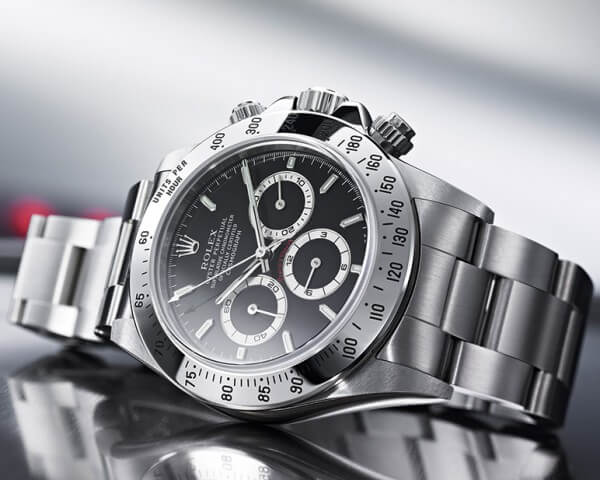
Incremental changes
Around this time, in 1965, the Daytona signature appeared on certain dials. Initially reserved for watches sold on the American market, it is said to have been requested by Rolex’s US subsidiary to highlight the partnership between the brand and the Daytona International Speedway, and to seal the link between the watch and motor racing. This trait was gradually extended to all dials, printed in red letters curved above the subdial at 6 o’clock.
Even after the quartz revolution of the 1960s-70s, Rolex remained loyal to the mechanical watch in general and to the Cosmograph Daytona in particular, which in 1988 incorporated a self-winding movement. This high quality chronograph calibre was already commercially available; however, Rolex made extensive modifications, replacing over half the original components with its own parts to bring the movement in line with its specifications.
The result, the 4030 calibre, featured a Rolex “heart”, i.e. an oscillator with variable inertia balance, Microstella regulating pins, and a hairspring with Breguet overcoil, completed by the Perpetual rotor which the brand had invented in 1931. Changes went beyond the movement: the diameter of the Oyster case was increased from 36 to 40 mm and crown-guard “shoulders” were added. The metal tachymeter bezel was made wider and engraved with a scale graduated to 400 units.
More innovations
In 2000, a completely new self-winding chronograph calibre was introduced, this time entirely designed and manufactured by Rolex: calibre 4130. It replaced the conventional lateral clutch with a vertical clutch to activate the chronograph functions. Rolex’s engineers cut the number of parts in the 4130 calibre by 60%. One way they achieved this was to simplify the chronograph hour and minute counter system by integrating the two mechanisms into one module.
This innovation also had the advantage of freeing up space, which Rolex used to increase the size of the barrel which now provided 72 hours of power reserve compared with 50 hours previously. The modern-day Cosmograph Daytona movement also uses a Parachrom hairspring. Developed, patented and manufactured by Rolex in a niobium/zirconium alloy, it is described as unaffected by magnetic fields and variations in temperature, and more resistant to shocks, thereby increasing the movement’s precision.
Rolex, which last year extended its production site in Biel, isn’t stopping there. The brand, which is the world’s biggest in revenue terms (estimated at CHF 4 billion) will be rolling out more innovations over the coming years without ever betraying the spirit of its flagship watch. You don’t play around with a jewel in the crown. ■







